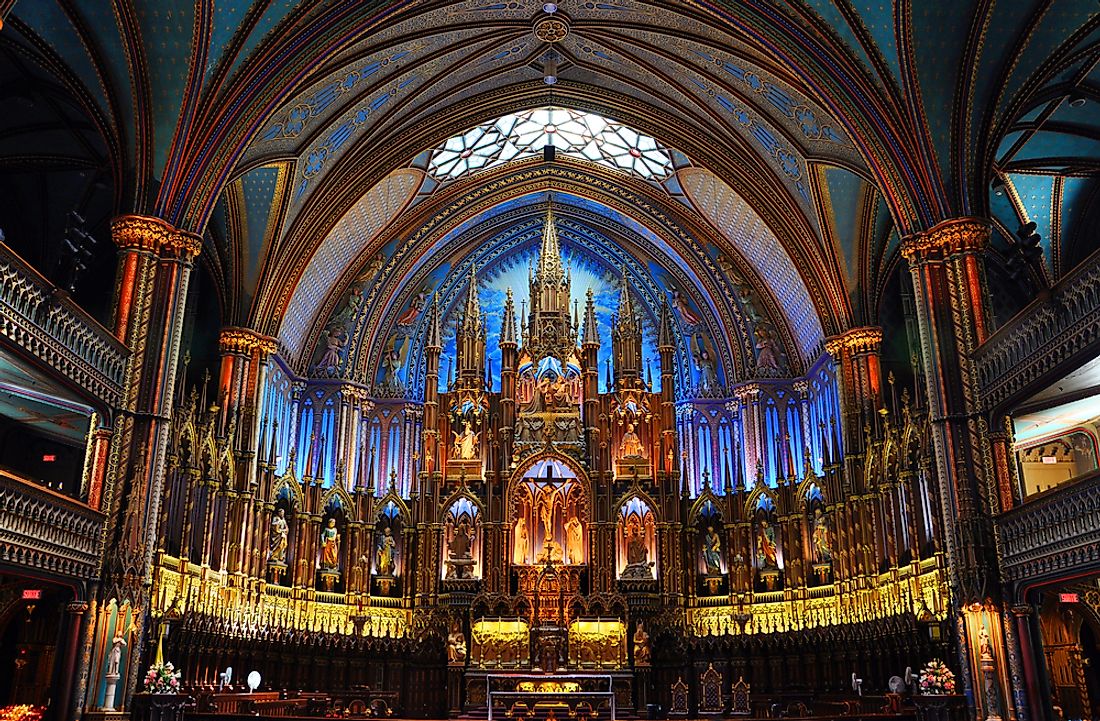Major Religions of Canada

Beginning in the late 1600s, Canada was explored and colonized by both the French and the British. Christianity was the most prevalent religion, with French colonists primarily being Catholic Christians, while British colonists were mainly Protestant Christians. This religious heritage is still apparent today, with almost 70% of Canadians identifying as Catholic or Protestant. That being said, Canada's vibrant and diverse immigrant population has introduced a number of different religions to the country.
Canada's Largest Religions
A plurality of Canadians today identify as Roman Catholic, making up approximately 39% of the population. 29% identify as Protestants, which are further divided into a variety of branches including Adventists, Anabaptists, Anglicans, Baptists, Calvinists, Lutherans, Methodists, and Pentecostals. 24% of Canadians are currently atheist or agnostic, and these do not follow any religion at all.
Cultural and Religious Diversity in Canada
Of Canada's minority religions, the most prevalent is Islam. Three percent of the population identify as Muslim, and every metropolitan Canadian city has a thriving Muslim community, comprised of immigrants from almost every Muslim country in the world. Most Canadian Muslims follow Sunni Islam, although the Shia and Ahmadiyya sects are also significantly represented.
Two percent of Canadians practice Hinduism. There have been three major influxes of Hindu practitioners over the years. The first group of Indian immigrants began arriving in British Columbia over one hundred years ago, and immigration continues today. The second major Hindu group emigrated from Sri Lanka between the 1940s and the 1980s, settling mainly in the greater Toronto area. The third group is comprised of Canadian converts to various branches of Hinduism, largely through the efforts of such groups as the Hare Krishna movement over the past fifty years.
Sikhism, Buddhism, and Judaism are each practiced by 1% or less of Canada's population. Sikhs, identifying as both a religious and an ethnic group, comprise Canada's largest South Asian population. More than 5,000 Sikhs emigrated to Canada between 1904 and 1908, and despite racial discrimination and prohibitive immigration policies in the first half of the 20th Century, the population has been steadily growing. Sikh communities first began to thrive in British Columbia, and now they are present in metropolitan areas throughout the country.
Buddhism was introduced to Canada by Chinese and Japanese settlers during the 19th Century. While the Japanese Jōdo Shinshū was historically the most prevalent form of Buddhism practiced in Canada, immigration reforms in the 1950s brought an influx of immigrants from Sri Lanka, Japan, and other Southeast Asian nations with a variety of Buddhist traditions. Tenzin Gyatso, the exiled Tibetan Buddhist leader and Nobel laureate, was made an honorary Canadian citizen in 2006.
Jewish Canadians are members of the fourth largest Jewish community in the world. Most are descended from the Ashkenazi ethnic group, but other notable groups include Sephardic Jews, Mizrahi Jews, and converts to the Jewish faith. The first Jewish immigrants arrived in the 18th Century. Emigration increased from the 1830s to the end of World War II, as Jews sought to escape pogroms, antisemitism and the Holocaust in Europe. Most of Canada's Jewish population lives in Ontario and Quebec.
Religious Composition Of Canada
| Rank | Belief System | Share of Canadian Population |
|---|---|---|
| 1 | Roman Catholic Christianity | 39% |
| 2 | Protestant Christianity | 29% |
| 3 | Atheist or Agnostic | 24% |
| 4 | Islam | 3% |
| 5 | Hinduism | 2% |
| 6 | Sikhism | 1% |
| 7 | Buddhism | 1% |
| 8 | Judaism | 1% |











